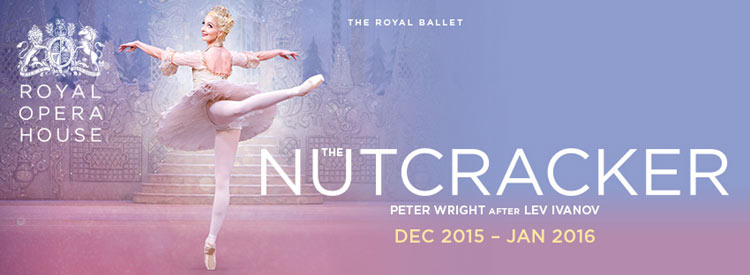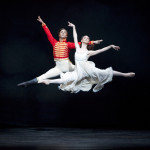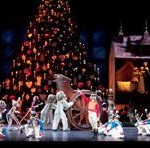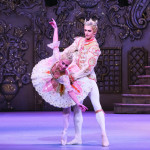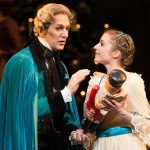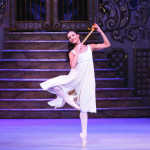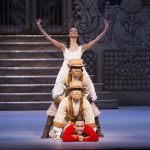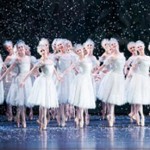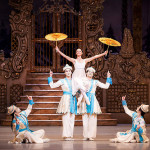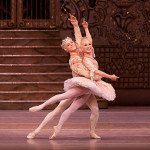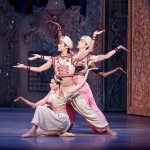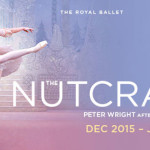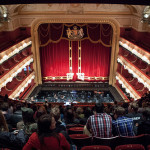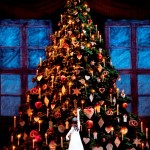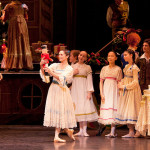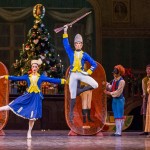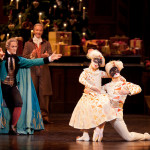If you’re going to visit your first ballet, this is a pretty good way to start. Strictly speaking, I have seen the Nutcracker before on TV, but at the Royal Opera House is as good as it gets – short of the Bolshoi in Moscow.
Even if, like me, you don’t fully appreciate all the nuances of the balletic medium, The Nutcracker is undeniably a charming and delightful Christmas spectacle, demonstrates immense technical skill and proficiency on the part of the dancers (and indeed the actors), is married to a glorious score (“Tchaikovsky’s glittering score” says the ads), and taking place within the plush confines of an historic setting (history of the ROH Covent Garden building here, the Royal Opera company here and the Royal Ballet here), home to some of the greatest ever performers.
It certainly helps to swot up on the story in advance (see here and here – full text at the bottom of this review), given the lack of libretto to drive narrative and express emotions, though you could easily pick up the human interaction through expressions, mime and movement. But equally you could watch and enjoy the choreography and music on its own merits.
This is a compact production, each half roughly 50 minutes sandwiched either side of a 30-minute interval where the audience can take advantage of champagne and nibbles at the excellent, spacious and beautifully modernised facilities.
The score is the initial attraction here, including as it does music that transports many an old codger (myself included) back to the magic of Christmas as a child. Who could listen to the Dance of the Sugar Plum Fairy without casting off the world-weary shroud cynicism and feeling once again that spark of youthful excitement? Tchaikovsky‘s musical accompaniment is a whirl of delightful and romantic melodies to entrance the audience, yet is married perfectly to the movements. This description is borrowed from the ROH website:
Pyotr Il’yich Tchaikovsky’s Nutcracker score was commissioned by the director of the Russian Imperial Theatres, following the resounding success of The Sleeping Beauty in 1890. Marius Petipa created the scenario, which is based on a fairytale by E.T.A. Hoffmann, and Lev Ivanov provided the choreography. The Nutcracker was first performed in 1892 at the Mariinsky Theatre in St Petersburg. It initially had a poor reception, but its combination of enchanting choreography and unforgettable music has since made it one of the best-loved of all ballets.
In Peter Wright’s classic production, the stage sparkles with theatrical magic – a Christmas tree grows before our eyes, toy soldiers come to life to fight the villainous Mouse King and Clara is taken to the Kingdom of Sweets on a golden sleigh. Tchaikovsky’s score contains some of the best-known melodies in ballet, from the flurrying sounds of the Waltz of the Snowflakes to the dream-like Dance of the Sugar Plum Fairy. Julia Trevelyan Oman’s designs draw upon 19th-century images of Christmas, making this a magical production for the festive season.
There is no doubt the traditional choreography (which changes little between productions, unlike, say, Shakespearean plays) fits Tchaikovsky’s music to a tee, and is danced with nary a step out of placed by a fine cast, among which Francesca Hayward in the role of Clara stood out by virtue of poise and delicacy, alongside Gary Avis‘s authoritatively magical Drosselmeyer.
While the fantasies and diversions from around the world are beautifully enacted, the best of all for me are the Christmas party scenes with snow outside; these remind us of the best of our childhood – and in this case a magically expanding Christmas tree and gifts from Drosselmeyer that include a large wooden nutcracker in the form of a gallant soldier.
I may not visit another ballet (though two more operas are booked!), but for me and my daughter, this is one special occasion that will stay long in the memory.
The Nutcracker Ballet Story
The Most Common of Many Variations
The Nutcracker Ballet is based on the story “The Nutcracker and the King of Mice” written by E.T.A. Hoffman. Although what is seen on the stage today is different in detail from the original story, the basic plot remains the same; The story of a young German girl who dreams of a Nutcracker Prince and a fierce battle against a Mouse King with seven heads.When Marius Petipa had the idea to choreograph the story into a ballet, it was actually based on a revision by Alexander Dumas, a well known French author. His version reflects more of what we have come to love as the Nutcracker Ballet.
The Party Scene
It is Christmas Eve at the Stahlbaum house — A large and grand house with the most beautiful tree imaginable. The Stahlbaums are hosting their annual Christmas party, welcoming the arrival of their family and friends. The children, Clara and Fritz, are dancing and playing as they welcome their friends too.
The party grows festive with music and dance as godfather Drosselmeyer arrives. He is a skilled clock and toy maker and always full of surprises. Drosselmeyer draws everyone’s attention as he presents two life-size dolls. They are the delight of the party, each taking a turn to dance.
The children begin to open gifts when Drosselmeyer presents his to Clara and Fritz. Although his gift to Fritz is quite nice, he gives Clara a beautiful Nutcracker that becomes the hit of the party. Fritz becomes jealous and, having a bit more spunk than a boy should have, grabs the nutcracker from Clara and promptly breaks it. Clara is heartbroken looking on as Drosselmeyer quickly repairs the Nutcracker with a handkerchief he magically draws from the air.
As the evening grows late, the guests depart and the Stahlbaum family retires for the evening. Clara, worried about her beloved Nutcracker, sneaks back to the tree to check on him, falling asleep with him in her arms.
The Fight Scene
As the clock strikes midnight strange things begin to happen. Clara begins shrinking as her beautiful Christmas tree grows high above her. The toys around the tree come to life while the room fills with an army of mice, led by the fierce Mouse King. As the Nutcracker awakens, he leads his army of toy soldiers into battle with the mice. The Mouse King corners the Nutcracker and battles him one-on-one. The Nutcracker seems to be no match for the Mouse King.
The Nutcracker and his army can go on no longer and are captured by the mice and their King. Clara makes a final daring charge throwing her slipper at the Mouse King, hitting him square on the head. The Mouse King drops to the floor and the mice run away, carrying off their leader’s lifeless body.
The Land of Snow
The Nutcracker turns into a Prince and takes Clara on a journey to the Land of Snow, an enchanted forest wonderland where they are welcomed by dancing snowflakes.
The Land of Sweets
The Prince escorts Clara to the Land of Sweets where they are greeted by the Sugar Plum Fairy. The Prince tells her about their daring battle with the army of mice and she rewards them with a celebration of dances.
- The Spanish Dance
- The Arabian Dance
- The Russian Dance
- The Chinese Dance
- The Mirliton Dance
- The Waltz of Flowers
As a finale, the Sugar Plum Fairy and the Cavalier dance a beautiful Pas De Deux.
The Dream Ends
Clara awakens from her dream and finds herself by her Christmas tree with her beloved Nutcracker.

